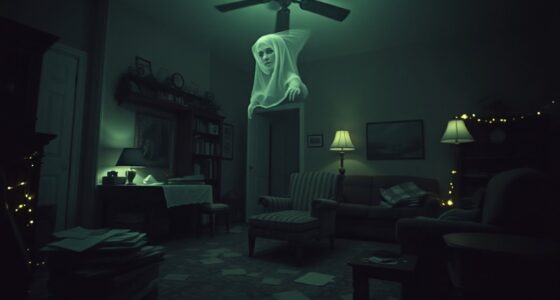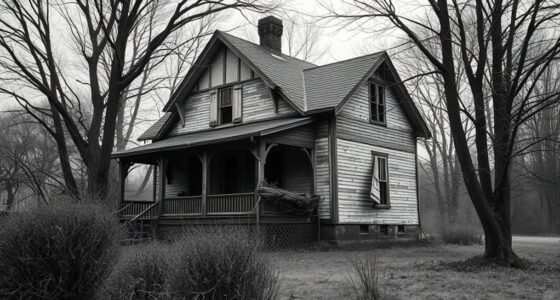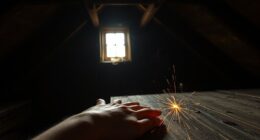Ghostwatch is a famous BBC hoax from 1992 that blurs reality and fiction through a mock documentary and live broadcast tricks. You see a supposedly real paranormal investigation, but it’s carefully scripted and crafted to look authentic. Many viewers believed it was real, causing panic and outrage, which impacted the BBC’s reputation. If you keep exploring, you’ll uncover how this daring stunt influenced television ethics and future broadcasts.
Key Takeaways
- Ghostwatch was a 1992 BBC Halloween program that used live broadcast techniques to create the illusion of a genuine paranormal investigation.
- It combined scripted scenes and spontaneous footage to blur the line between reality and fiction, shocking many viewers.
- The hoax led to widespread panic, with some viewers calling emergency services, raising ethical concerns about deception and public safety.
- The incident damaged the BBC’s reputation, prompting stricter broadcasting policies and discussions on media ethics and responsibility.
- Ghostwatch is considered a pioneering but controversial example of reality-style entertainment that challenged media transparency and trust.
The Concept and Creation of Ghostwatch
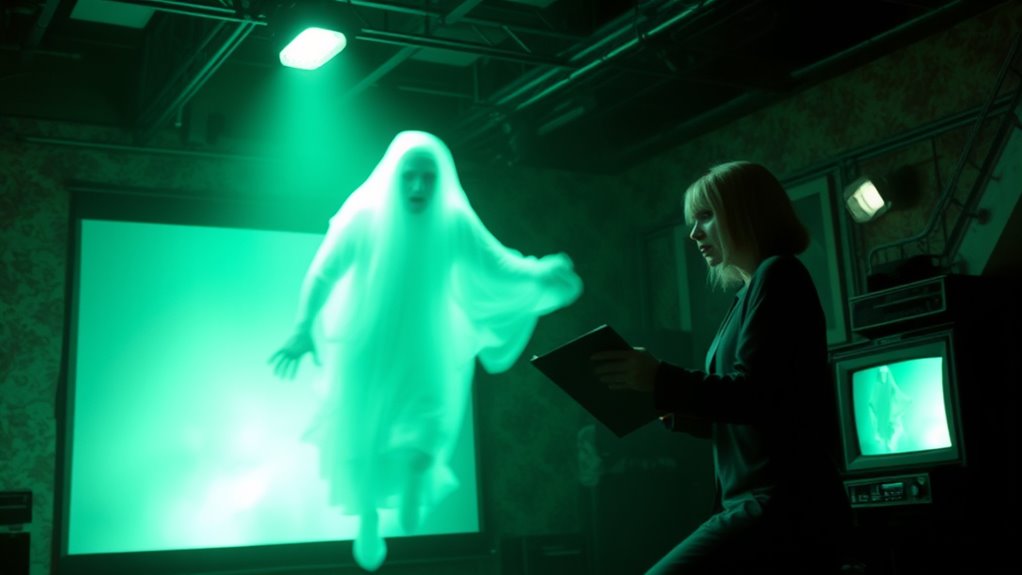
Ghostwatch was conceived as a pioneering television experiment that aimed to blur the lines between reality and fiction. The creators wanted to explore paranormal phenomena through a live broadcast format, making viewers question what was real. They designed the show as a mock documentary, blending scripted scenes with spontaneous moments to increase the illusion. This approach allowed them to use broadcast deception effectively, convincing audiences that they were watching a genuine investigation into supernatural activity. The goal was to evoke fear and curiosity by presenting paranormal phenomena as real, creating an immersive experience. They also incorporated live broadcast techniques to heighten the realism and immediacy of the show. By pushing the boundaries of traditional TV storytelling, Ghostwatch set out to challenge viewers’ perceptions and spark debates about the ethics of televised deception. Additionally, they carefully managed audience engagement to maintain suspense and authenticity throughout the broadcast.
The Broadcast Format and Presentation Style
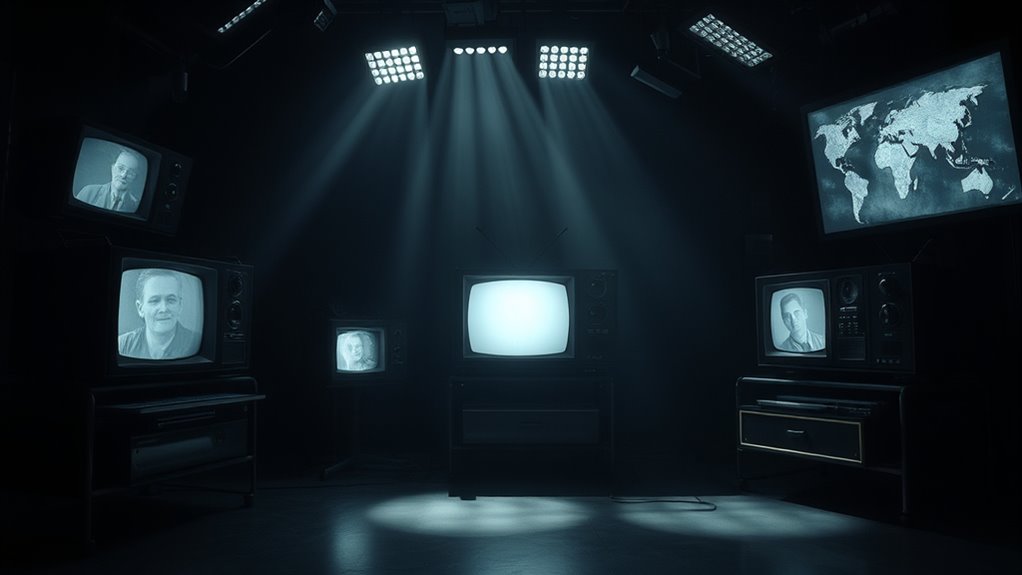
The show’s broadcast format combined live footage with pre-recorded segments, creating a seamless and immersive experience that blurred the line between reality and fiction. You notice how the broadcast framing makes it feel authentic—merging real-time interviews with staged visuals. The visual aesthetics contribute to this illusion, employing dark lighting and unsettling camera angles to heighten tension. This careful presentation style keeps you engaged, as the mix of media forms fosters a sense of immediacy and realism. The table below highlights key aspects:
| Aspect | Description |
|---|---|
| Live Footage | Real-time interactions heighten authenticity |
| Pre-recorded Segments | Crafted scenes ensure consistent visual narrative |
| Broadcast Framing | Used to create a cohesive and believable flow |
| Visual Aesthetics | Dark lighting and camera angles amplify eeriness |
| Presentation Style | Combines elements to evoke a sense of immediacy |
Additionally, the deliberate use of visual storytelling techniques enhances the overall impact of the broadcast, making the hoax more convincing. The integration of media forms such as live and pre-recorded segments further blurs the boundaries between reality and fiction, increasing the sense of authenticity. This blending of media elements is a key tactic used to sustain viewer engagement and credibility. Moreover, the strategic use of perception management techniques plays a crucial role in maintaining the illusion of reality throughout the broadcast. Implementing these strategies demonstrates a sophisticated understanding of psychological manipulation, which is essential in creating a convincing hoax.
Public Reception and Immediate Reactions
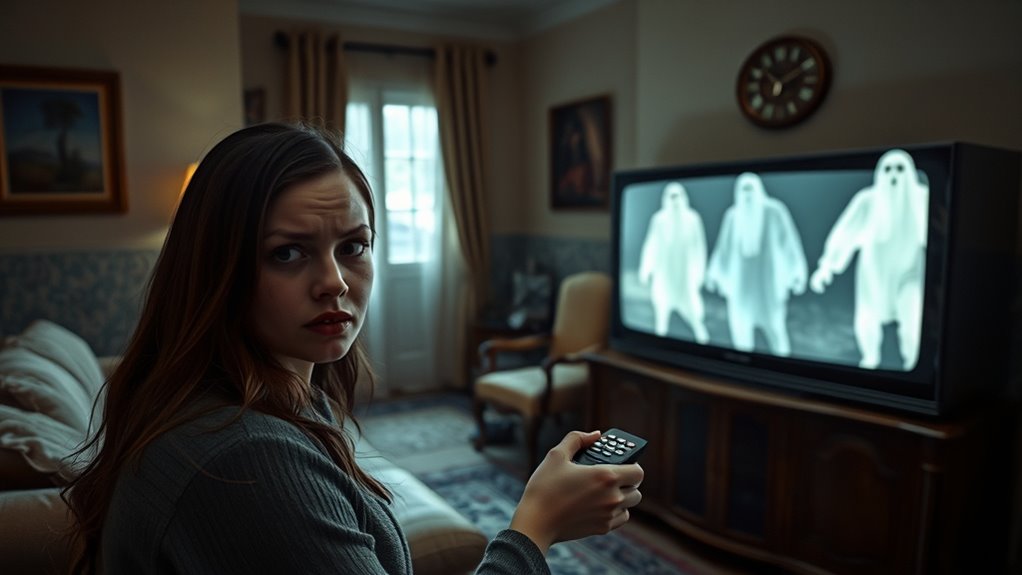
When Ghostwatch aired, many viewers believed they were watching a real broadcast, causing shock and panic across the audience. The media quickly responded, amplifying the controversy and spreading the story further. This incident sparked widespread public debate about the limits of broadcast deception and viewer trust. The event also raised questions about the ethical boundaries of media ethics in media productions, as audiences felt deceived by the program’s realistic presentation. The event exemplifies the importance of media ethics and responsible storytelling in entertainment. Additionally, the incident highlighted how public perception can be heavily influenced by the presentation of content, especially when it blurs the line between reality and fiction. The episode became a case study in the impact of audience reactions to deceptive programming and the importance of maintaining clear boundaries between fiction and reality in media.
Viewer Shock and Panic
Did viewers really believe they were watching a genuine live broadcast? The shock was immediate and intense. Many viewers, caught up in media sensationalism, believed the terrifying events were real. Panic spread quickly, with some calling emergency services, convinced someone was in danger. Others questioned their skepticism, unsure if they had been deceived. The broadcast blurred the line between reality and fiction, fueling widespread alarm. To understand the chaos, consider this table:
| Audience Reaction | Media Response | Impact on Public Perception |
|---|---|---|
| Fear and panic | Media outlets initially deny | Blurred reality lines |
| Calls to authorities | Rapid spreading of rumors | Increased skepticism |
| Immediate concern | Coverage amplifies shock | Heightened distrust |
| Confusion and doubt | Some viewers realize hoax | Lingering paranoia |
This chaos underscores how media sensationalism and viewer skepticism collided, creating a nationwide panic. The event’s impact on public trust highlights the importance of media literacy and critical thinking in evaluating sensational stories.
Media’s Rapid Response
As the shocking broadcast aired, media outlets scrambled to respond, often rushing to shape the narrative rather than providing immediate clarification. Many news organizations debated whether to condemn the hoax or sensationalize it further, highlighting issues of media ethics. Some outlets criticized the BBC for deception, questioning their responsibility to maintain trust with viewers. Others sensationalized the event, fueling public outrage and skepticism. Your immediate reactions reflected the chaos, with conflicting reports muddying the truth. The rapid response exposed how quickly information spreads and how easily public trust can be damaged when media outlets prioritize sensationalism over accuracy. This rush to judgment underscored the fragile nature of viewer trust and the importance of responsible journalism in moments of crisis. Additionally, the event underscored the significance of media’s rapid response, and the impact of public reception on shaping the narrative in real-time. Furthermore, the incident highlighted how the diverse designs available in media coverage can influence public perception and understanding of the event. The event also demonstrated how the influence of global accolades, such as awards and recognition, can shape a media narrative and public opinion in the aftermath of a controversy. Recognizing the importance of accurate information dissemination can help prevent similar incidents from escalating misinformation.
Public Debate Sparks
The immediate aftermath of the Ghostwatch broadcast ignited a fierce public debate, with viewers and critics quickly voicing their opinions and reactions. Many experienced public outrage, feeling the show crossed ethical boundaries and misled viewers. The controversy centered on media ethics, questioning how the BBC justified such a hoax on prime-time television. The incident sparked widespread discussion about the responsibility of broadcasters in protecting public trust. Here are some key reactions:
- Outrage from parents worried about children being scared.
- Critics condemning the show’s deceptive nature.
- Calls for stricter regulations on televised content.
- Defenders arguing it was an innovative, if controversial, form of storytelling.
This debate highlighted tensions between creative expression and social responsibility, leaving a lasting mark on broadcasting standards.
The Role of Media Warnings and Viewer Disbelief
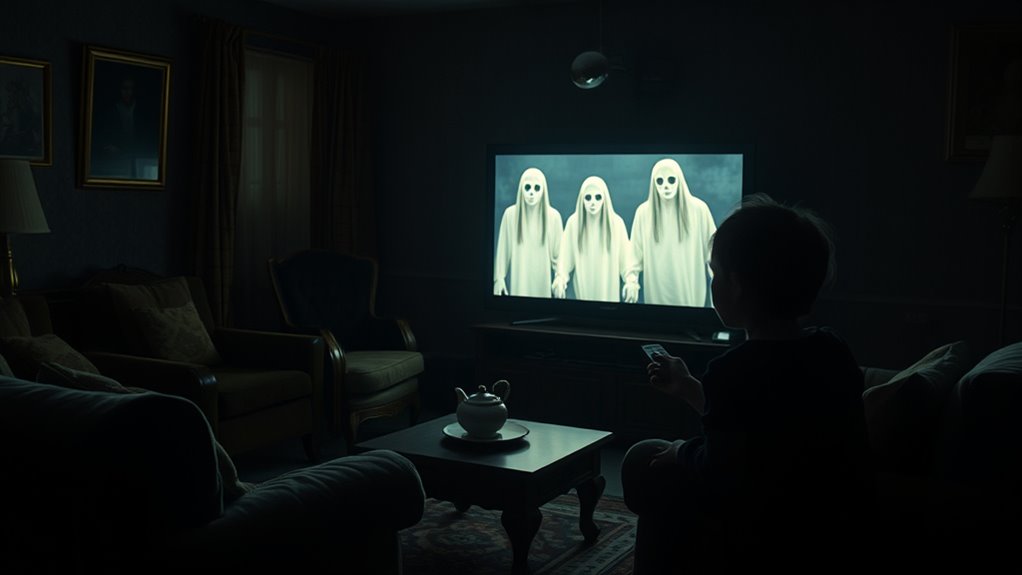
Media warnings play a vital role in shaping how you interpret and respond to controversial broadcasts like Ghostwatch. They serve as crucial cues that promote media literacy, helping you distinguish between fiction and reality. When warnings are clear, you’re more likely to approach content with a healthy level of viewer skepticism, reducing the risk of misunderstanding its intent. The table below highlights key factors influencing your perception:
| Factor | Effect on Viewer Disbelief | Example |
|---|---|---|
| Warning Clarity | Reinforces skepticism | Explicit disclaimers |
| Content Presentation | Impacts trust | Dramatic vs. factual cues |
| Audience Awareness | Shapes response | Prior media literacy |
| Context Provided | Promotes critical thinking | Historical background |
| Repetition of Warnings | Reinforces message | Pre-broadcast notices |
The Impact on BBC’s Reputation and Policies
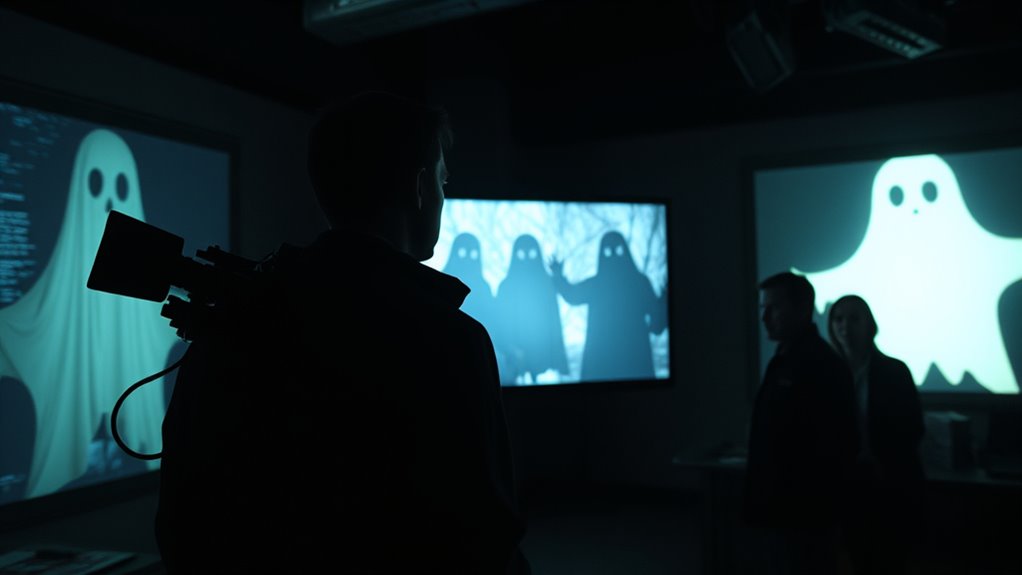
Ghostwatch’s broadcast considerably damaged the BBC’s reputation, exposing vulnerabilities in its trustworthiness and editorial oversight. As a result, public trust in the BBC took a hit, prompting immediate policy reconsiderations. The incident led to:
- Stricter media ethics guidelines to prevent similar hoaxes.
- Enhanced oversight of live broadcasts to ensure transparency.
- Public relations adjustments to rebuild trust after the controversy.
- A more cautious approach to sensational content, emphasizing accountability.
This event forced the BBC to reflect on its responsibility to uphold media ethics and protect its credibility. The fallout showed how quickly public trust can erode when ethical standards are compromised, emphasizing the importance of integrity in broadcasting.
The Ethical Dilemma Surrounding the Hoax
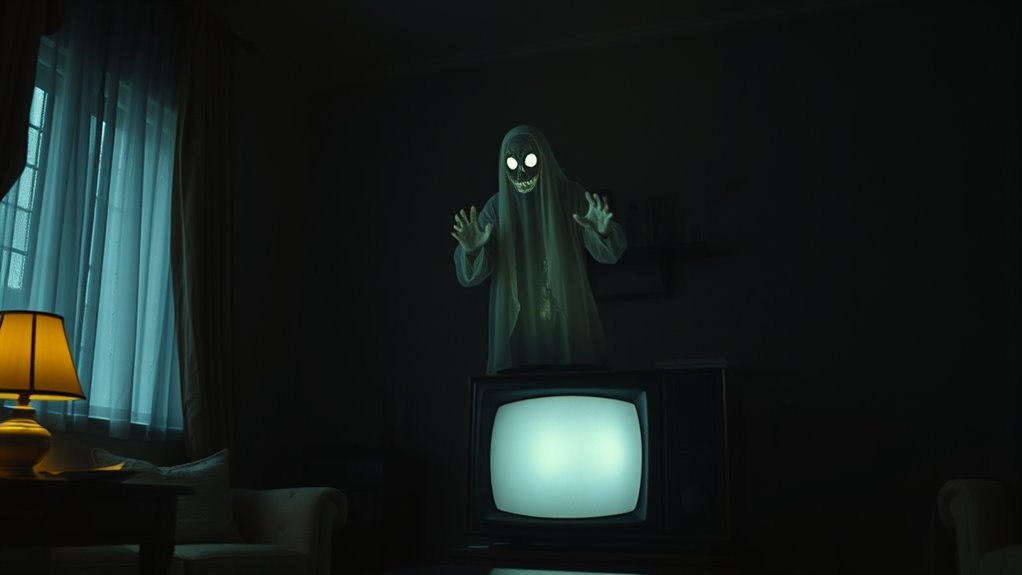
While the BBC aimed to create a groundbreaking Halloween broadcast, the hoax sparked a fierce ethical debate about whether entertainment should justify deception. You must consider the moral implications of misleading viewers, especially when it involves frightening audiences without warning. Media responsibility comes into question—should broadcasters prioritize shock value over honesty? Many argue that the hoax blurred the line between entertainment and manipulation, risking public trust. Others believe that in pushing creative boundaries, the BBC took a calculated risk that ultimately challenged industry standards. However, the controversy highlights the critical need to balance innovation with ethical integrity, ensuring that viewers aren’t deceived in ways that could cause lasting harm or diminish confidence in media outlets.
How Ghostwatch Influenced Future Broadcasts
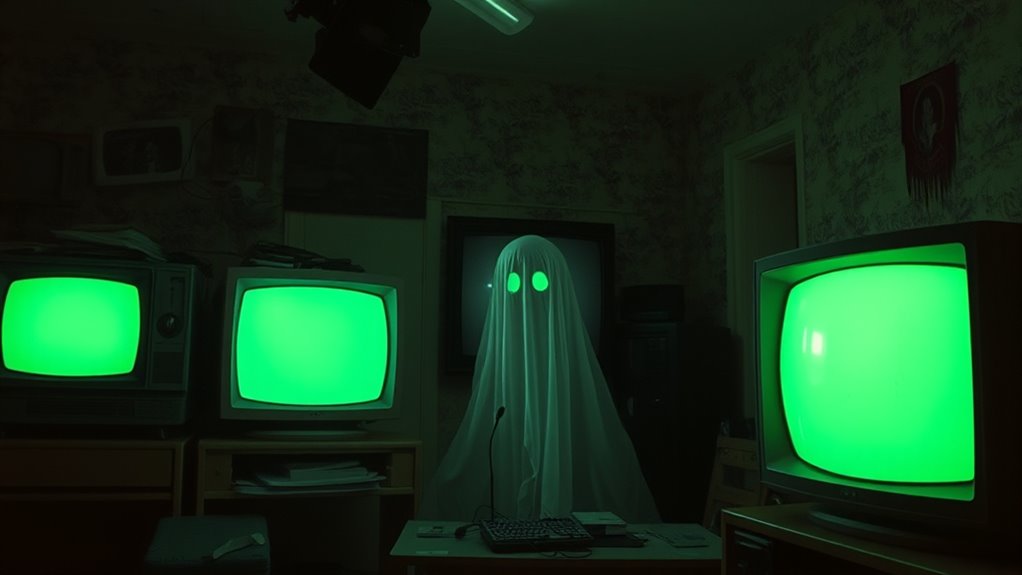
Ghostwatch changed how broadcasters approach reality-style programming, blurring the lines between fiction and fact. It also sparked ongoing ethical debates about honesty and responsibility on air. Its legacy has led to stricter censorship and a more cautious outlook on innovative storytelling techniques.
Pioneering Reality TV Style
By blurring the lines between reality and entertainment, Ghostwatch set a new standard for how television could manipulate viewer perceptions. It pioneered a style that would heavily influence future broadcasts, especially in reality TV. You see, its innovative use of technical innovation created a sense of immediacy and authenticity that captivated audiences. This approach changed how TV producers designed programs, emphasizing real-time audience engagement. Here are four ways Ghostwatch influenced future broadcasts:
- Incorporating live footage to heighten realism
- Using on-screen personalities for a personal touch
- Blurring fiction and reality to increase suspense
- Creating a sense of unpredictability that kept viewers hooked
This style became a blueprint for many reality TV shows, shaping the way stories are told on screen.
Ethical Broadcast Concerns
The controversial success of Ghostwatch sparked a reevaluation of ethical standards in television broadcasting. You realize that media ethics and broadcast responsibility are vital to maintaining public trust. The hoax blurred lines between reality and fiction, prompting broadcasters to question how far they can go in pursuing sensational content without misleading viewers or causing harm. This incident made networks more cautious about transparency and the potential impact of their programming. You see that future broadcasts now face increased scrutiny to ensure they respect ethical boundaries, especially around portraying real events or using deception. Ghostwatch’s fallout underscored the importance of balancing entertainment with responsibility, influencing broadcasters to develop clearer guidelines and prioritize viewer safety and honesty in their content.
Legacy and Censorship
The fallout from Ghostwatch’s controversial broadcast led to lasting changes in how networks approach sensitive content. The intense public backlash and concerns over media censorship prompted broadcasters to tighten regulations. As a result, future programs became more cautious, avoiding formats that could confuse or shock viewers. Here are four ways Ghostwatch impacted broadcasting:
- Stricter media censorship policies to prevent similar hoaxes.
- Heightened scrutiny of live broadcasts, especially Halloween or horror-themed events.
- Increased awareness of the potential harm caused by deceptive content.
- Greater emphasis on transparency and clear viewer warnings to avoid backlash.
This legacy reminds networks to balance creative freedom with responsibility, ensuring that media censorship evolves to protect audiences while respecting artistic expression.
Viewer Stories and Personal Accounts of Fear
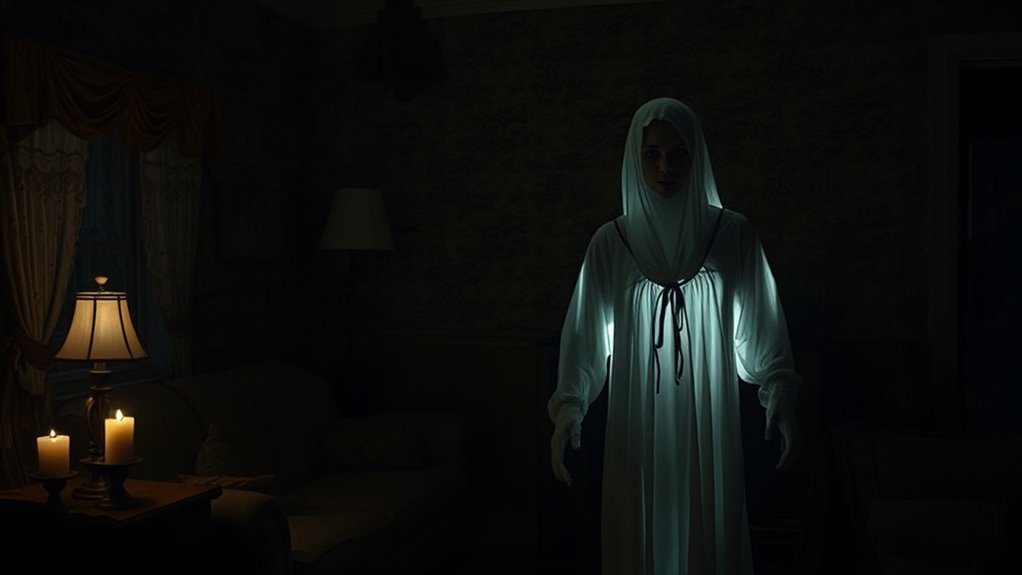
Have you ever wondered how watching Ghostwatch left viewers genuinely terrified? Many viewers, even those skeptical of the paranormal, found themselves shaken after the broadcast. Some recount feeling haunted by the scenes, struggling to separate fiction from reality. Their personal accounts reveal a mix of disbelief and trauma, as the haunting atmosphere seemed almost real. Despite widespread skepticism about the paranormal, the show blurred boundaries, leading viewers to question what they’d seen. For some, it triggered nightmares or anxiety long after the broadcast ended. These stories highlight how powerful the special was in invoking fear, regardless of prior beliefs. Ghostwatch didn’t just scare people in the moment; it left an indelible mark on their memories and perceptions of the supernatural.
Cultural and Media Legacy of the Special
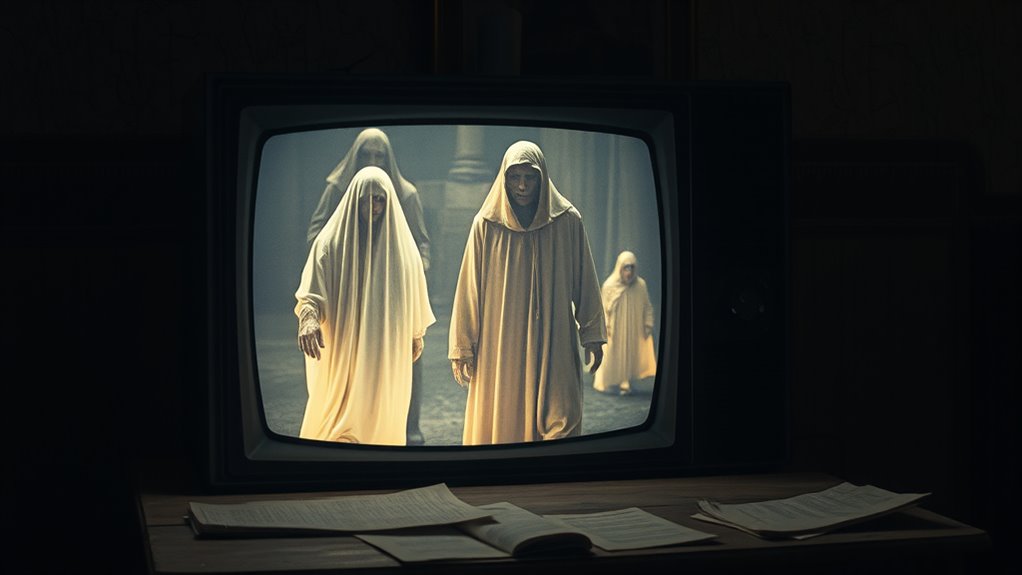
Ghostwatch’s intense emotional impact didn’t fade after the broadcast; it sparked a lasting influence on popular culture and media. It challenged viewers to question media responsibility and how audience perception shapes reality. This special changed how broadcasters approached controversial content, highlighting the importance of ethical storytelling. Its legacy includes:
- Inspiring future Halloween specials that blend reality and fiction.
- Prompting discussions about media ethics and accountability.
- Influencing how audiences interpret televised content.
- Sparking debates about the limits of entertainment and responsibility.
You now see how Ghostwatch’s shock value and clever deception left a mark beyond just scare tactics, encouraging a more critical view of what you consume on screen and how media influences perception.
Lessons Learned From the Ghostwatch Incident

The Ghostwatch incident taught broadcasters and audiences valuable lessons about media ethics and the importance of transparency. It revealed how media manipulation can deceive viewers and blur the lines between reality and fiction. As a result, broadcasters learned to prioritize ethical considerations, ensuring that audiences are not misled or harmed by false claims. The incident emphasized the need for clear disclaimers and responsible storytelling, especially when simulating real events. It also highlighted the importance of maintaining trust between media outlets and viewers. Moving forward, media organizations became more cautious about how they present fictional content, recognizing that transparency is essential to uphold credibility and prevent similar controversies. Ultimately, Ghostwatch served as a cautionary tale about the power and responsibility of the media.
Frequently Asked Questions
Were Any BBC Staff Involved in Creating Ghostwatch’s Hoax Storyline?
You might wonder if BBC staff were involved in creating Ghostwatch’s hoax storyline. Behind the scenes controversy and staff involvement rumors swirl around whether producers or on-air talent knew more than they admitted. Some believe certain staff members may have been complicit, while others insist it was a strictly scripted production. Despite the rumors, no concrete evidence confirms direct staff involvement, fueling ongoing debate about the true extent of their role.
How Did the Hoax Affect Future BBC Programming Guidelines?
You see, the hoax made the BBC tighten its broadcast regulations to combat audience skepticism. They implemented stricter guidelines to guarantee content transparency and prevent similar incidents. This shift aimed to rebuild trust and maintain credibility with viewers. As a result, future programming became more cautious, emphasizing clear distinctions between entertainment and reality, ultimately fostering a more responsible broadcasting environment that respects audience skepticism and upholds journalistic integrity.
Did Any Viewers Experience Long-Term Psychological Effects?
You might wonder if viewers faced long-term psychological trauma or ongoing anxiety after watching intense programs. While some individuals could have experienced short-term viewer anxiety or distress, most people recover quickly. However, a few may develop lasting psychological trauma from particularly frightening content. It’s essential for broadcasters to contemplate mental health impacts and provide appropriate warnings, helping viewers manage potential psychological effects and reducing the risk of long-term harm.
Were There Legal Consequences for the Producers or Broadcasters?
You might think the creators faced jail time, but no, the legal repercussions weren’t quite that dramatic. Instead, broadcasters faced regulatory responses, with the BBC receiving criticism and warnings. The producers escaped serious legal consequences, proving that sometimes, even a haunted hoax can slip through the legal cracks. So, while they stirred controversy, they didn’t get sued or thrown behind bars—just a hefty dose of regulatory scolding.
How Has Ghostwatch Influenced Modern Televised Ghost Storytelling?
You see, modern televised ghost storytelling has evolved to emphasize television realism, making viewers feel like they’re witnessing real events. This approach heightens audience perception, blurring the lines between fiction and reality. Ghostwatch’s impact is evident, as producers now craft shows that mimic authentic investigations, increasing suspense and engagement. Its influence has shaped how ghost stories are presented, making them more immersive and believable, ultimately enhancing the thrill for viewers.
Conclusion
As you reflect on Ghostwatch’s chilling legacy, remember that even the most convincing illusion can blur the line between reality and fiction. It’s a haunting reminder that media’s power to deceive can ripple far beyond a single broadcast, shaping perceptions and fears. Like a ghost lingering in the shadows, its influence persists—warning you to always question what’s real and what’s just a cleverly crafted trick hiding behind the screen.


